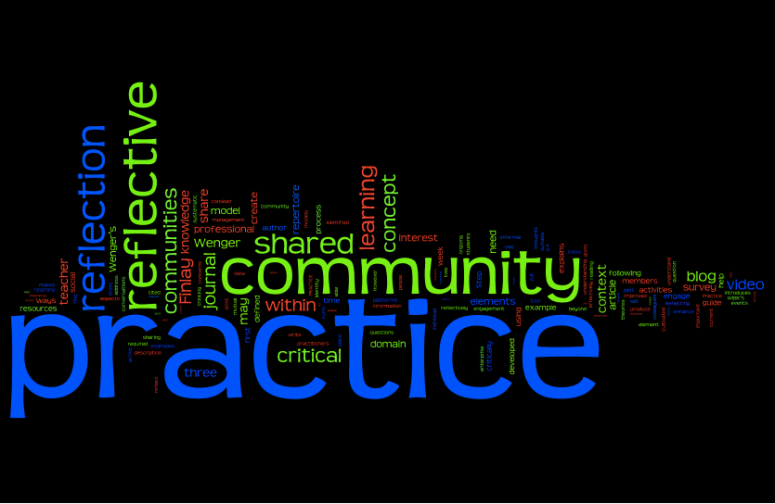
Our THOUGHTS and FEELINGS the WHY? How? and SO WHAT? = REFLECTION
WHEN? WHERE? WHAT? = DESCRIPTION
The DESCRIPTION puts the REFLECTION in CONTEXT
REFLECTION is EMPOWERING = CHANGE for the FUTURE!
“Communities of practice are defined as a group of people who share a passion for something they know how to do and who interact regularly to learn how to do it better. The purpose is to create, expand and exchange knowledge and to develop individual capabilities.” (Knox, 2009)
Step 1: Identify my community of practice.
My wider community of practice is my school teacher community, a more specific community of practice would be the Year 5/6 team as that is where I teach and who I spend most of my time with.
Step 2: Explain the three elements of your community of practice.
What is the joint-enterprise or the shared domain of interest that you identify with your community of practice?
The area of inquiry and the key issue at stake for the Year 5/6 team is preparing ourselves for 2017. At present we teach in two teams of two. In 2017 we will move to teaching in a power of four. Physical changes are also occurring within our learning environment to enable this to happen.
What are some examples of the activities or events that the members in your community of practice engage? How often do the activities or events take place?
We have whole school staff meetings every Monday and Year 5/6 team meetings every Tuesday. Both of these meetings occur after school. We also have two days per term that the Year 5/6 team use to meet and plan collaboratively.
What kind of shared repertoire does your community of practice produce?
As a team we are relatively new. Three of us have only been at the school for this year so we are slowly building a shared repertoire:
- we have a common language;
- we collaborate on planning and share this via Google Docs;
- we are beginning to create clear routines moving forward to 2017;
- we are developing a shared understanding of what learning is for us;
- we are creating a bank of shared resources across a variety of curriculum areas;
- we recognise and acknowledge each others strengths and are beginning to use these effectively to make our team stronger and the learning more valuable for the students in this more collaborative environment.
Step 3: Define your practice within the community of practice using the the following questions to guide your thoughts:
What sense of connectedness or belonging do you have within your community of practice?
I have found this difficult at times as I am new to the school this year. As the year has progressed I have felt a stronger sense of connection, especially with our students. I don’t always feel I belong, but I think this is due to the fact that I was at my last school for eight years, so any change is going to be difficult. As a team we have an awesome opportunity to create an amazing learning environment for our tamariki. We all have very different strengths to bring to the table, the trick is harnessing these and enabling the flow of learning to take place.
How would you describe your role within the community of practice? For example, a leader? A facilitator? An active member? A newcomer?
This question is very interesting. I am definitely the newcomer in a number of ways. I am not only new to the school, but new to the Primary teaching system as the past 8 years have been in Year 7/8 at a High School. I have also come from a leadership position and am now a team member. I am also a facilitator in my areas of strength, as all on the team are. I facilitate a range of professional development focussed on digital technology and gamification and the use of it to enhance student engagement, motivation and outcomes.
At what extent you are contributing towards your community of practice?
I feel I contribute a lot. We all work well together to share our areas of strength and develop each others capabilities. I have grown as a teacher this year from being a member of this team.
References:
Knox, B. (2009, December 4).Cultivating Communities of Practice: Making Them Grow.. Retrieved fromhttps://www.youtube.com/watch?v=lhMPRZnRFkk
Wenger, E.(2000).Communities of practice and social learning systems.Organization,7(2), 225-246 (Link to the article in Unitec Library).
